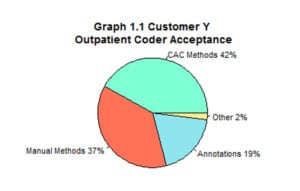Inside Angle
From 3M Health Information Systems
Annotations: A closer look
In my last blog post, I talked about Coder Acceptance methods and I introduced the idea of rolled up CAC methods and rolled up manual methods. I also went over how one can figure out how much room for improvement their enterprise, facility or individual coder has through the “Opportunity for Increased Use of CAC” formula. Just as a reminder, Opportunity for Increased Use of CAC = Recall – CAC Methods. Today, I want to dig a little deeper into annotations by comparing the actual benefit of inpatient vs. outpatient annotations.
Annotations Standing on Its Own
I labeled annotations as part of manual methods in my last blog because they are not computer-assisted generated codes. However, I also noted that annotations are still “somewhat” of a CAC method because they are part of a CAC system and help add value to it – particularly in outpatient coding, as I will explain. Therefore, we can take annotations out of “manual methods” and have it be its own category of “annotations.” We will examine the significance of taking annotations out of manual methods for both inpatient and outpatient, but first we can begin by looking at Customer Y’s coder acceptance break down for all inpatient final billed codes in the graph below.

The formula to derive the total impact of our CAC system is thus: CAC Methods + Annotations = Total Impact of CAC system.
Now, for inpatient coding, annotations are not generally a recommended primary workflow – coders should try to add the codes as suggested by CAC to maximize productivity. Most of our customers use inpatient annotations minimally – the average inpatient annotation acceptance out of total final billed codes for April 2016 was 5%. I will discuss annotations relative to other workflow methods after we walk through outpatient.
For outpatient, coding annotations play a different and more substantial role in maximizing the benefit of CAC systems. Let’s look at Customer Y’s outpatient coder acceptance for total final billed codes in the graph below.

Productivity of Inpatient vs. Outpatient Annotations
Is it okay that annotations for outpatient are quite a bit higher than for inpatient for Customer Y? Actually, yes it is okay and it’s a good thing! The reason? Because when we analyze the amount of time it takes coders to accept codes through different pathways or methods, we find that annotations are faster than using a typical CRS pathway for outpatient, but slower than a typical CRS pathway for inpatient. For both inpatient and outpatient, however, workflows of evidence view, codes pane and even document evidence (which are all based on CAC auto-suggested codes) are faster than typical CRS pathways for both inpatient and outpatient. We will release more about coding acceptance methods relative to one another in another data blog post, but in order to do that we had to first dig deeper into annotations and how it is still added value – particularly for outpatient.
Stay tuned and as always, if you’re interested in how this relates to your data, head over to the support site and download your metrics!
Clarissa George is a business intelligence specialist at 3M Health Information Systems.


